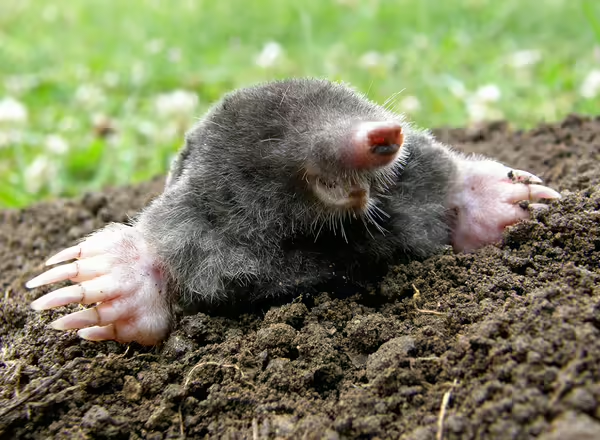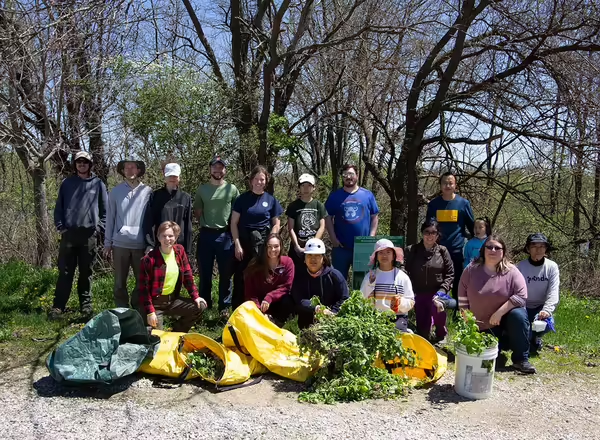Explore Illinois Wildlife
In 1800, Illinois had huge prairies. In fact, approximately 61% of Illinois was covered with prairie. There were also very large forests. Forests covered approximately 32% of Illinois. The streams, rivers, and lakes in Illinois were clear and contained no pollution. Water covered approximately one percent of Illinois. Wildlife were very abundant. Wildlife that no longer exist in Illinois, such as the black bear, wolf, and bison, could be found.
Since the early 1800s, there have been many changes to Illinois' natural ecosystems. Today, about 10% of the forests and 1% of the prairies remain. Wetland ecosystems cover about 500,000 acres in Illinois today, compared to more than 9 million acres of wetlands in the early 1800s. People have changed the land in Illinois through agricultural use, flood control activities, the development of towns and cities, and pollution.
Wildlife depend on certain types of ecosystems or habitats for their food, water, shelter - where they live - and space - the amount of habitat needed. These basic needs must be available to a population of animals in order to survive. When part or all of an animal's habitat is removed or polluted, the animal population goes down or dies off completely.
When one population of animals in an area increases or decreases, populations of other animals or plants may also increase or decrease. All the living things, plants, and animals in an ecosystem are interrelated or connected.
There are many ways people can help wildlife populations. People who own land in Illinois can plant trees, shrubs, or wildlife food plots. Streams, rivers, ponds, and lakes can be protected from pollution and sedimentation, which is soil that is moved by rain into a stream. Nesting boxes and bird feeders can be put out for wildlife when natural nesting areas or food supplies are scarce.
There are many public and private agencies and organizations that help people understand, manage, and protect the natural environment in Illinois. People can also help our environment by getting involved with these conservation organizations.
Challenge yourself to find a way to get involved in your community to help manage and protect your natural resources.
Wildlife populations depend on their environment or habitat to receive the basic needs for survival. An ecosystem or habitat provides populations of wildlife with food, water, shelter and space. If all four of these basic needs are not available in a suitable arrangement, populations of wildlife can not exist.
All populations of living things are interrelated. When one population of animals, plants, or insects increases or decreases, other populations of living things are also affected. For example, when shrubs and brushy areas are removed from an ecosystem, the rabbit population will likely go down. The reduced rabbit population will lower predator populations that use rabbits as a food source.
In another example, let's assume all the dead, hollow trees are removed from a forest ecosystem. Cavity nesting animals such as bluebirds, nuthatch, wrens, screech owls, squirrels, and woodpeckers have very little, if any, shelter available. The number of animals of this type would be reduced. Insect populations could increase because of fewer insect-eating birds, and trees, and other plants could be negatively affected. The whole ecosystem is affected.
The amount of suitable habitat for a species of wildlife will determine the number of animals that can survive in the area. Human activity has the greatest impact on the amount and quality of wildlife habitat in Illinois. Wildlife habitat can be destroyed or its quality diminished as a result of urban sprawl, agricultural practices, pollution, sedimentation, or habitat fragmentation.
People can also have a positive impact on wildlife populations through the improvement and protection of habitats or ecosystems. The planting of trees and shrubs, as well as wildlife food plots in the appropriate locations is one way that landowners can improve wildlife habitat. People can protect ponds, streams, rivers, and wetlands from sedimentation by reducing soil erosion on lands surrounding these aquatic ecosystems. Nesting boxes placed in ecosystems that lack dead, hollow trees will enhance the habitat for cavity-nesting animals. There are many things people can do to improve habitat for wildlife.
Objective
To help students understand the interrelationships of animals with components of their natural ecosystem.

Assign students to study groups of two or three members. Each group should select an animal they would like to learn more about. Using references from the classroom or library, each group should determine their animal's requirements for food, water, shelter and space. Groups can report to the rest of the class about their animal through a short written report and/or a poster which describes their animal's habitat.

Have students think about, or actually observe, human activity around their community that impacts - positively or negatively - wildlife populations. As a class or individually, make a list of these activities. What types of wildlife might be impacted? What part or component of the habitat is being impacted? Are the activities producing positive or negative impacts on wildlife populations?

Make a list of things that could be done in your community to improve or protect wildlife habitat. Present your ideas to your local government, natural resource conservation agency, or choose one that your class could do something about.
There are a number of natural resource management agencies in Illinois that can help people enhance and protect wildlife habitat. Listed below are a few of the public agencies that can provide ecosystem management expertise to people in Illinois.
- Illinois Department of Natural Resources: In addition to wildlife biologists, foresters and fisheries biologists, this agency has private lands biologists to assist landowners in setting management goals and developing plans that will enhance wildlife habitat.
- Illinois Acres For Wildlife
- Habitat Stamp and Waterfowl Stamp monies
- Illinois Nature Preserve System
- Natural Resource Conservation Service, formerly Soil Conservation Service: This agency provides technical assistance to landowners in such areas as soil conservation, watershed management and establishing tree windbreaks.
- University of Illinois Extension: This agency provides educational programs concerning the management of ecosystems, agricultural systems, and urban environments.
There are also many private conservation organizations which work to understand, manage and protect our natural environment in Illinois.